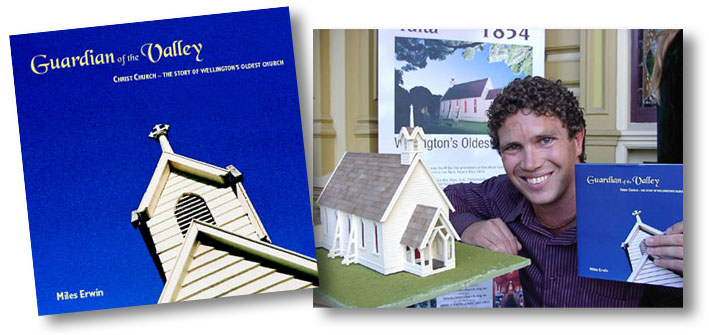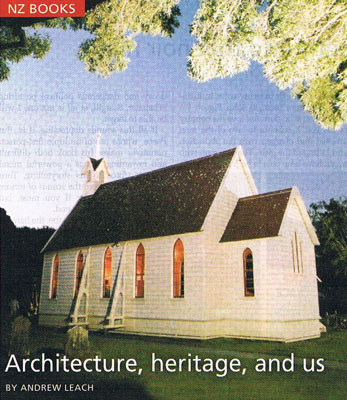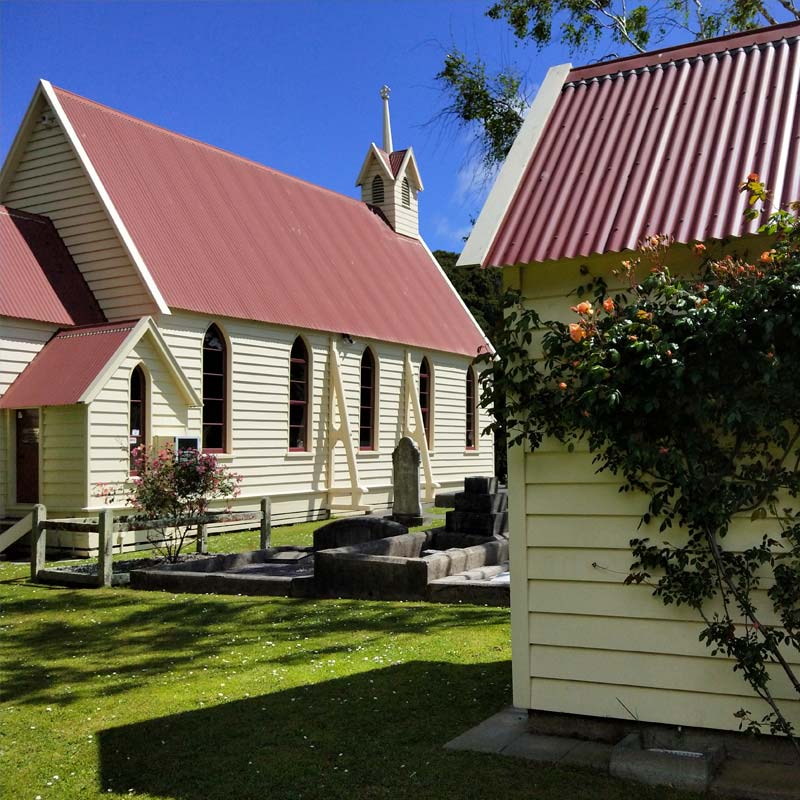‘Guardian of the Valley, Christ Church – Written by Miles H. Erwin

Photo (right): Hutt News
Thanks to the generosity of Pub Charity, the history of Christ Church, written to celebrate the 150th anniversary of the Church in 2004, has been reprinted.
Copies are $20 plus $6 postage and may be obtained by emailing the Society at info@christ-church.org.nz or from Mary Stevens. mhrstevens@gmail.com Phone 04 476 6247
Payment direct into the bank account 020528 0019498 00
BNZ Lower Hutt Branch.
Listener Book Review by Andrew Leach
 GUARDIAN OF THE VALLEY
GUARDIAN OF THE VALLEY
The story of Wellington’s oldest church, by Miles Erwin (Steele Roberts)
Miles Erwin’s Guardian of the Valley reinforced my prejudices as to what constitutes good architectural historio-graphy. It anchors a history of Taita and its peoples to the modestly charming timber structure of Christ Church, bringing the juggernaut of local folklore and genealogical research carefully and intelligently to bear upon the subject. Marking 150 years since the church’s foundation, the book’s tone is unashamedly celebratory and it is hard to resist the writer’s enthusiasm. But although Erwin’s history of the region is clear and even-handed, it advances the important question of how and why places enter into our heritage consciousness.
A survivor of fire, flood and suburbia, Christ Church is a remarkable artefact of Wellington’s early settlement. Erwin shares what is known of the building’s formal origins. There is evidence, but no proof of the original designer’s identity. More central to Erwin’s story are the contractor and his assistants, drawn from within the original Taita community. But the modest timber structure belongs to the group of simple yet elegant buildings erected by the Anglican Church all over the country in the mid-to- late 19th century.
At the heart of this charming and well-presented volume is the argument that Christ Church witnessed the transformation of its Pakeha population from mere colonials (arriving in the 1840s) to people of the land. This unfolded in the fierce heritage battle waged in 1950 and 1951, in which members of the local congregation and descendants of the now enormous settler families rallied around the cause of preservation in the face of a church anxious to relocate the building to serve a more needy community. At stake in these debates was the question of whether a building as young as Christ Church (less than a century old at the time) could be considered valuable enough, in its own terms, to treasure.
The movement to protect Christ Church identified and celebrated the foundations of a colonial community; further, it clearly drew on a strong familial connection of the heritage battlers to those settler families. As part of the 1950s groundswell to recognise New Zealand’s own architectural heritage, it provides poignant insights into a cultural coming of age.
Guardian of the Valley brings that awareness into the present, reminding contemporary readers of a time when New Zealanders doubted the importance of their own architectural history and felt ambivalent about its protection. The problems persist today, with our ability to value 20th-century architectural heritage. This book, among others, builds up a wider sense of architecture’s importance to community life and national identity, past and present.
 Edited by Malcolm McKinnon
Edited by Malcolm McKinnon
Published by Steele Roberts, Wellington
Apart from the history of Christ Church the book is a history of the early settlement of Taita/Naenae and the pioneer families that settled in the area. It follows many settler family stories and discusses the trials and tribulations they went through in a young colony. These people, the very first organised settlers to come to NZ, contributed a great deal to our society and the church that they built in 1853, Christ Church, is a living memorial to their endurance and the fine workmanship with which they built this church.
The historical events that have happened to Christ Church over its 150 years are recorded in the book, as is the reason for the formation of the Christ Church Preservation Society (Inc.), and the influence Christ Church had on Parliament passing the New Zealand Historic Places Act.
Guardian of the Valley is the first book published about the church and is a very exciting read for anyone with an interest in Christ Church; the early settlement of the Taita/Naenae area; and history in general.
It was launched at a function hosted by the New Zealand Historic Places Trust on 29 January 2004 and is now available.
Cause for Celebration: Christ Church, Taita, turns 150
Review of “Guardian of the Valley” published in the Newsletter of the Wellington Branch of the NZHPT. Written by Diana Beaglehole.
Celebrations to mark the 150th anniversary of Christ Church, Taita, began on 29 January when a history of the church, Guardian of the Valley, was launched at Antrim House. The book was written by Miles Erwin and launched by John Terris, mayor of Lower Hutt. The Anglican church of Christ Church is the oldest surviving church in the Wellington region and one of the oldest in New Zealand. It was built in 1853, and the first service, which included a baptism, was held on New Year’s Day 1854. The first marriage was conducted 10 days later: that of Mary Jane Mabey and James Harris, the great-great-grandparents of Miles Erwin, author of Guardian of the Valley. Many of the people attending the launch of Erwin’s book were also descendants of original and early parishioners, and there were descendants too of clergy associated with the church and of settler families in the Taita district. Erwin gives biographical details of the people involved with Christ Church at different stages of its history and points out relevant links between the various generations of each family. Because the history of Christ Church is closely bound up with the history of Taita, Erwin provides an historical background of the region and an outlines the changing patterns of settlement and land use. During its 150-year history Christ Church has survived earthquakes, floods, the threat of removal and a disastrous fire. It was in response to the proposed shifting of the church to Stokes Valley in 1950 that the Christ Church Preservation Association was formed in early 1951 to preserve and maintain the historic building and its churchyard. Composed largely of the descendants of early settlers, the association became the Christ Church Preservation Society in 1957. Under both names, this incorporated body has worked tirelessly to ensure that Christ Church survives as a living example of our spiritual and built heritage. It was appropriate that Guardian of the Valley was launched at Antrim House, because the campaign to save Christ Church stimulated public concern over the care and preservation of the country’s heritage and contributed towards the passing of the Historic Places Act of 1954. The act established the National Historic Places Trust, and in 1963 this name was amended to the New Zealand Historic Places Trust. Christ Church is registered by the Trust as a Category I historic place. That John Terris should launch the book was also appropriate, as he led the Restoration Appeal Committee that was set up to raise funds to repair Christ Church after a fire, lit by an arsonist, badly damaged the interior on 18 November 1989. In Guardian of the Valley, Miles Erwin demonstrates that the story of Christ Church and the community it serves is also the story of the people who have served and cherished the church over 150 years. Erwin contends, moreover, that the story is ‘merely the first chapter in a grand volume’. Let’s hope so. Meanwhile, Guardian of the Valley is a worthy addition to the literature of historic places in New Zealand. Guardian of the Valley is published by Steele Roberts and edited by Malcolm McKinnon.
Book review for the Newsletter of Lower Hutt Historical Society
Reviewer John Orman – Guardian of the Valley Christ Church the story of Wellington’s oldest church / Miles Erwin: 2004.
When during February 2004 Taita district celebrated the 150th birthday of its wooden Anglican Church, Christ Church, there were various events. The first was the launch of a book, Guardians of the Valley.
This lavish souvenir by Miles Erwin has the social history of European settlement just downstream from the gorge. The hardback is a fine object with some material new to the public domain. The author is to be congratulated for making and promoting it.
At the core of Erwin’s vision is a deeply felt account of 16 pioneer families. It is a remarkably rich & generous coverage of over half the families at Taita by the 1850s. There is perhaps by way of a bonus a fresh recounting of the military events along the river during May 1846.
A surprising aspect of the book though is this. The European styled homestead of the Mabey family is published but there is no attempt to say where it stood. The illustration seems undated.
Here, before May 1846 there were European and tribal farms. For instance, the c.1842-1890s Boulcott farm had included land near Section 38 where Almon Boulcott built a farmhouse. For instance, the c.1835-1940s Te Moko or Te Mako farm had included land near Section 43 where Te Ati Awa from Waiwhetu seem to have built another European styled farmhouse.
The book pinpoints neither. It also ignores who before May 1846 had farmed this riverbank & swamp. More beguiling still is this: the book has no map yet these farm sites were among those the NZ Company surveyed during the 1840s. This district too then was a scene of intense competition between Company farmers & coastal tribes bent on optimising new paddocks.
The book appears to forego a chance to integrate these families≠ accounts with the latest in state research into this period. During 2003 there emerged The Waitangi Tribunal report about the valley. This has maps that include Taita district from the 1840s.
The editing is scrupulous & gets the flavour of the 1850s. This achievement is supreme. To read these family accounts now puts the faces of these speakers in mind. That measures precisely high quality writing.
There is also obvious and careful proof reading. The book seems to avoid the glaring typos that often mar such publications. This is a fine book to celebrate Christ Church.
Mayoral Speech – Launch of Book marking 150th anniversary of Christ Church.
By Mayor John Terris
29th January 2004.
I’m delighted that we have been able to celebrate this 150th Anniversary of Christ Church in the right year. The story is told that the centenary was celebrated in 1945, by accident.
It was a major event, attended by descendants of pioneer families, the Prime Minister of the day Peter Fraser, the Finance Minister Walter Nash, the Opposition Leader Sid Holland and the Governor-General Sir Cyril Newill.
All accounts of the day say it was a great success. It was only sometime later that everyone realised the Church had not been built in 1845 but in 1854!
I understand this is one of the stories related in this fascinating new history of Christ Church, which we are here to launch.
Christ Church is important to us for many reasons, and it is timely to have a history reminding us of the significant role the Church has played in our Region’s history.
The Church is not only the oldest Church in the Wellington Region and one of the oldest in its original condition in New Zealand.
It’s also probably the oldest complete building in Wellington.
It’s important to us not only because it is a beautiful building but because it was built without using any nails.
The Church was built by a carpenter and joiner from Yorkshire, Sidney Hirst who is buried in its cemetery.
In a tribute to skills of a past era, the original mortise and tenon dowel joints still remain in the window frames, although the Totara roof has been replaced.
The Church is important to us not only because it holds a New Zealand Historic Places Trust category 1 registration.
It’s also a place in which many of the Hutt’s most famous families celebrated, mourned and worshiped.
The first service was held in this Church on New Year’s day 1854, at a time when Taita had a settler population of around thirty families. The first wedding at the Christ Church was on 10 January 1854 between James Harris and Mary Jane Mabey – two pioneer Hutt families, and a marriage I believe Ann Erwin is descended from.
Many more famous Hutt families have married, worshiped and been buried in the Church grounds.
Resting in its grounds are the Te Atiawa Chief Manihera Matangi, who signed the Treaty of Waitangi — and his wife Haana.
It is the last resting-place of a large number of Boulcotts, the family who gave us the name of the street in which we are gathered tonight.
I have had a personal connection to this Church.
I worked with many others on the restoration project following the deliberately lit fire that badly damaged the Church in 1989.
The community restored the Church because we need to value our heritage and our history and we don’t do that enough.
We have had cause in very recent years to lament that there isn’t more protection for our heritage buildings in the Hutt.
It’s ironic that this is an issue we are once again having to visit, because events in Hutt city surrounding Christ Church itself were the catalyst for the formation of the Historic Places Trust (as Ann Erwin has mentioned).
If ever there was proof of the value of heritage buildings in helping us to learn from the past, it is in the case of Christ Church.
The Church is emerging as one of our most important buildings yet it could so easily have been removed in the nineteen-forties, or lost in the eighties.
As we contemplate the 150 years Christ Church has stood, we should consider the conditions of the day that brought settlers from the other side of the world to live here.
We should consider the beautiful, if hard, country they found.
And we should consider the character and faith of the settlers that shaped their decision to make new lives here.
The results of their settlement are reflected in the beautiful city we enjoy today.
Their faith was reflected in this Church.
These people, the very first organised settlers to come to NZ, contributed a great deal to our society.
The Church that they built in 1853, Christ Church, is a living memorial to their endurance. Congratulations to miles on this history.
Congratulations to the preservation society on bringing your charge through to this grand old age.
It is my pleasure to formally launch this book and to wish the Church the best of luck for the next 150 years.
Ends.
Wedding Venue Bookings
To book a wedding email
or phone Daphne Daysh 04 977 2055 or 027 687 2055



